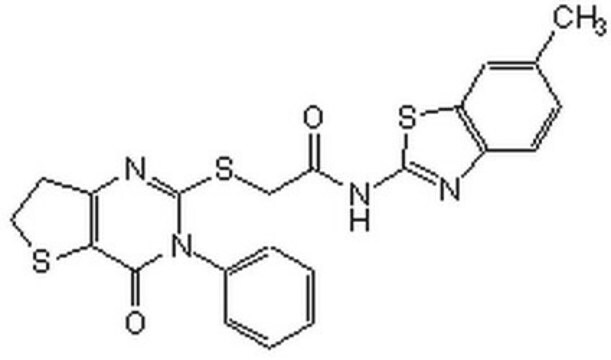推荐产品
生物源
rabbit
品質等級
抗體表格
affinity isolated antibody
抗體產品種類
primary antibodies
無性繁殖
polyclonal
物種活性
human
物種活性(以同源性預測)
rat (based on 100% sequence homology), canine (based on 100% sequence homology), sheep (based on 100% sequence homology), bovine (based on 100% sequence homology), porcine (based on 100% sequence homology)
技術
immunohistochemistry: suitable (paraffin)
western blot: suitable
同型
IgG
NCBI登錄號
UniProt登錄號
運輸包裝
ambient
目標翻譯後修改
unmodified
基因資訊
human ... SNAI2(6591)
一般說明
Zinc finger protein SNAI2 (UniProt: O43623; also known as Neural crest transcription factor Slug, SLUG, Protein snail homolog 2) is encoded by the SNAI2 (also known as SLUG, SLUGH) gene (Gene ID: 6591) in human. SLUG is a transcriptional repressor that modulates both activator-dependent and basal transcription. It is expressed in most adult human tissues, but is not detected in peripheral blood leukocyte. It is observed in discrete foci in interphase nuclei and these nuclear foci do not overlap with the nucleoli, the SP100 and the HP1 heterochromatin or the coiled body, suggesting its association with active transcription or active splicing regions. SLUG is shown to repress BRCA2 expression by binding to its E2-box-containing silencer and recruiting CTBP1 and HDAC1 in breast cells. It contains a SNAG domain (aa 1-20) that resembles a histone H3-like structure and functions as a molecular hook for recruiting LSD1 to repress gene expression in metastasis. SLUG is shown to be involved in the generation and migration of neural crest cells. It also plays a role in mediating RAF1-induced transcriptional repression of the TJ protein, occludin (OCLN) and subsequent oncogenic transformation of epithelial cells. In epidermal keratinocytes, it binds to the E-box in ITGA3 promoter and represses its transcription. SLUG is also involved in the regulation of ITGB1 and ITGB4 expression and cell adhesion and proliferation in epidermal keratinocytes. It can bind to E-box2 domain of BSG and activate its expression during TGFB1-induced epithelial-mesenchymal transition (EMT) in hepatocytes. SLUG phosphorylation by GSK-3 beta results in cytoplasmic localization and degradation. Mutation in SNAI2 gene can cause Waardenburg syndrome 2D that is characterized by sensorineural deafness, pigmentary disturbances, and absence of dystopia canthorum. (Ref.: Lin, Y et al. (2010). EMBO J. 29(11); 1803-16).
特異性
This rabbit polyclonal antibody detects SLUG/SNAI2 in human cells. It targets an epitope within 12 amino acids from the N-terminal half.
免疫原
Epitope: unknown
KLH-conjugated linear peptide corresponding to 12 amino acids from the N-terminal half of human Zinc finger protein SNAI2.
應用
Anti-SLUG (SNAI2), Cat. No. ABE993, is a highly specific rabbit polyclonal antibody that targets Zinc finger protein SNAI2 and has been tested for use in Immunohistochemistry (Paraffin) and Western Blotting.
Immunohistochemistry Analysis: A 1:250 dilution from a representative lot detected SLUG (SNAI2) in human bone marrow and human pancreas tissues.
Research Category
Epigenetics & Nuclear Function
Epigenetics & Nuclear Function
品質
Evaluated by Western Blotting in HepG2 cell lysate.
Western Blotting Analysis: 2 µg/mL of this antibody detected SLUG (SNAI2) in 10 µg of HepG2 cell lysate.
Western Blotting Analysis: 2 µg/mL of this antibody detected SLUG (SNAI2) in 10 µg of HepG2 cell lysate.
標靶描述
~31 kDa observed; 29.99 kDa calculated. Uncharacterized bands may be observed in some lysate(s).
外觀
Affinity Purified
Format: Purified
Purified rabbit polyclonal antibody in buffer containing 0.1 M Tris-Glycine (pH 7.4), 150 mM NaCl with 0.05% sodium azide.
儲存和穩定性
Stable for 1 year at 2-8°C from date of receipt.
其他說明
Concentration: Please refer to lot specific datasheet.
免責聲明
Unless otherwise stated in our catalog or other company documentation accompanying the product(s), our products are intended for research use only and are not to be used for any other purpose, which includes but is not limited to, unauthorized commercial uses, in vitro diagnostic uses, ex vivo or in vivo therapeutic uses or any type of consumption or application to humans or animals.
未找到合适的产品?
试试我们的产品选型工具.
儲存類別代碼
12 - Non Combustible Liquids
水污染物質分類(WGK)
WGK 1
閃點(°F)
does not flash
閃點(°C)
does not flash
Kai-Yen Peng et al.
Frontiers in oncology, 11, 716055-716055 (2021-09-28)
Over 90% of colorectal cancer (CRC) patients have mutations in the Wnt/β-catenin pathway, making the development of biomarkers difficult based on this critical oncogenic pathway. Recent studies demonstrate that CRC tumor niche-stromal cells can activate β-catenin in cancer-initiating cells (CICs)
我们的科学家团队拥有各种研究领域经验,包括生命科学、材料科学、化学合成、色谱、分析及许多其他领域.
联系技术服务部门